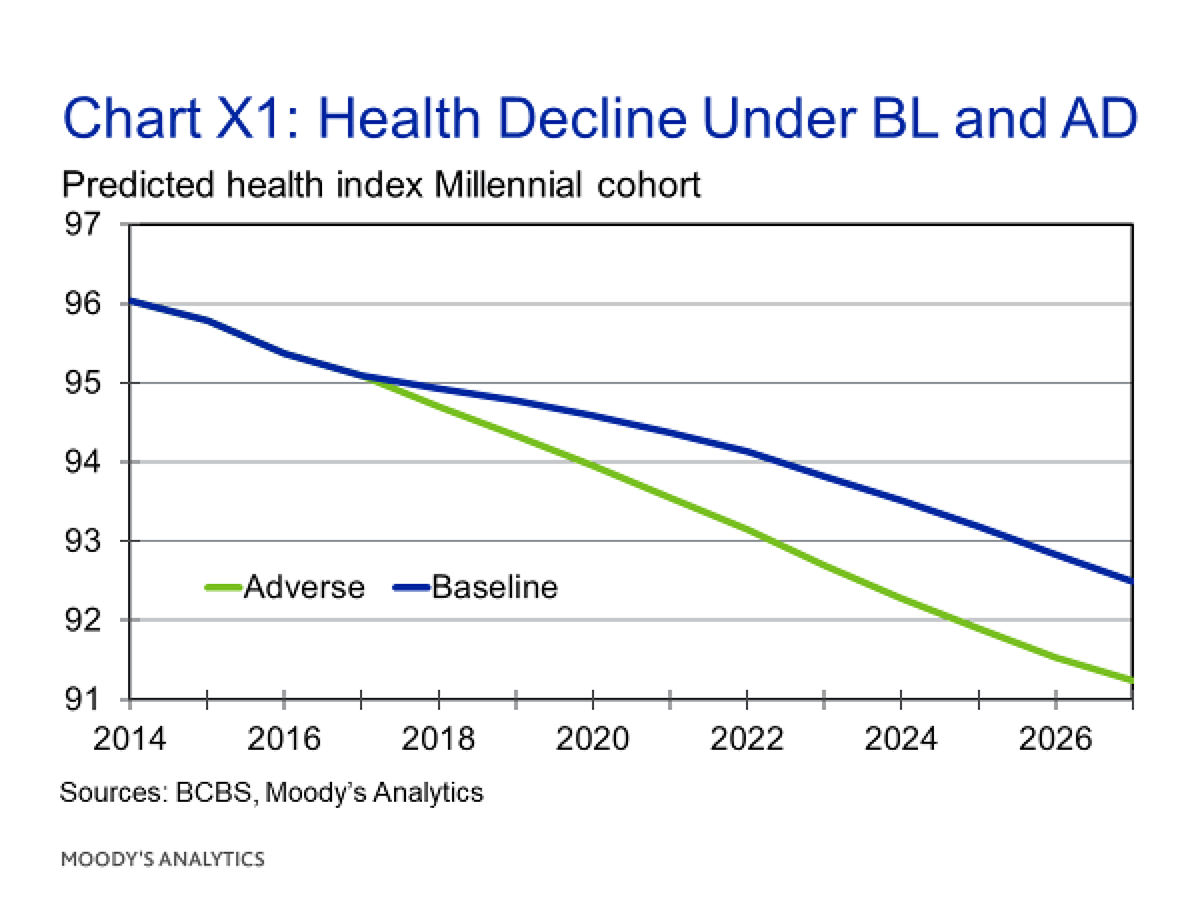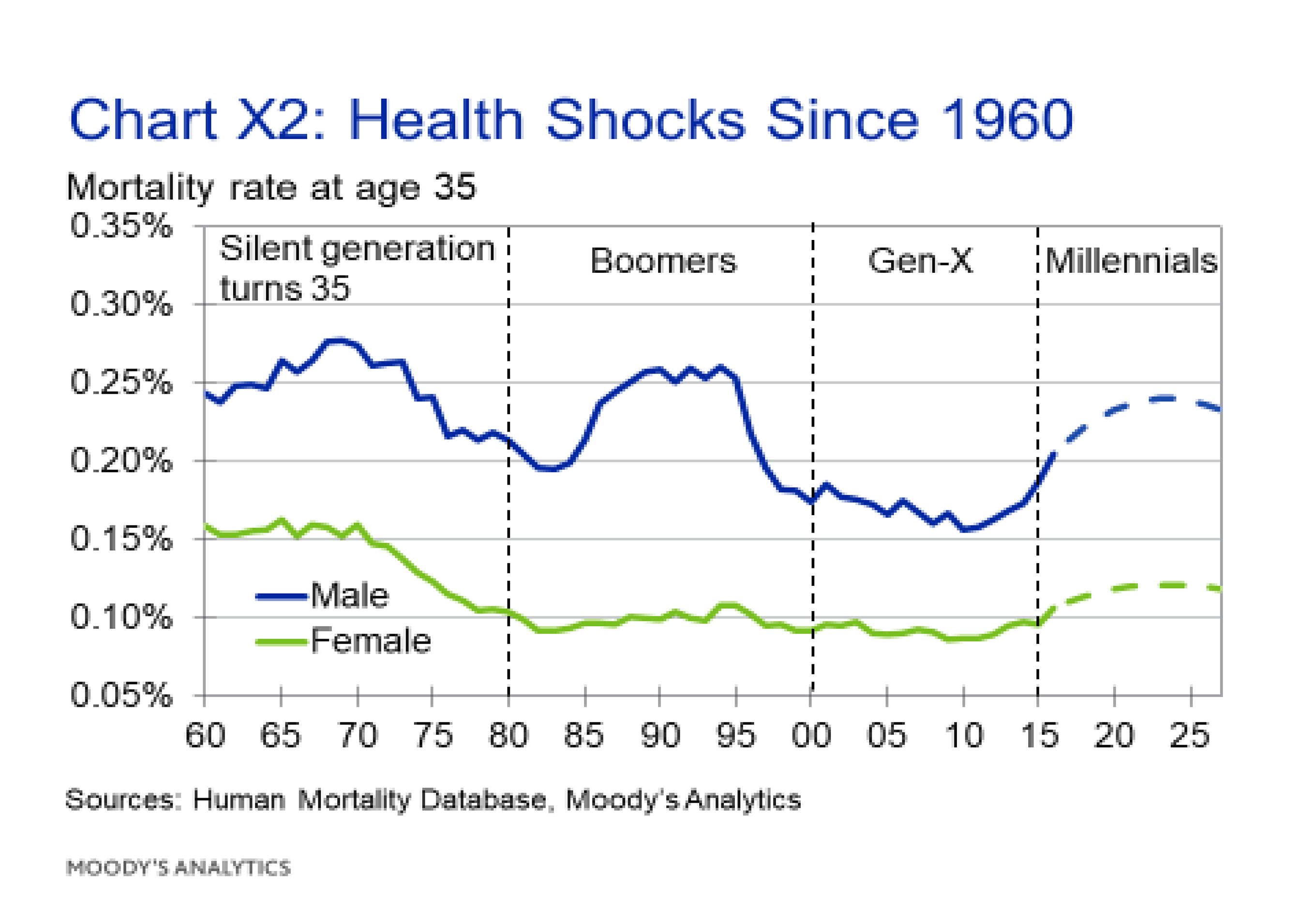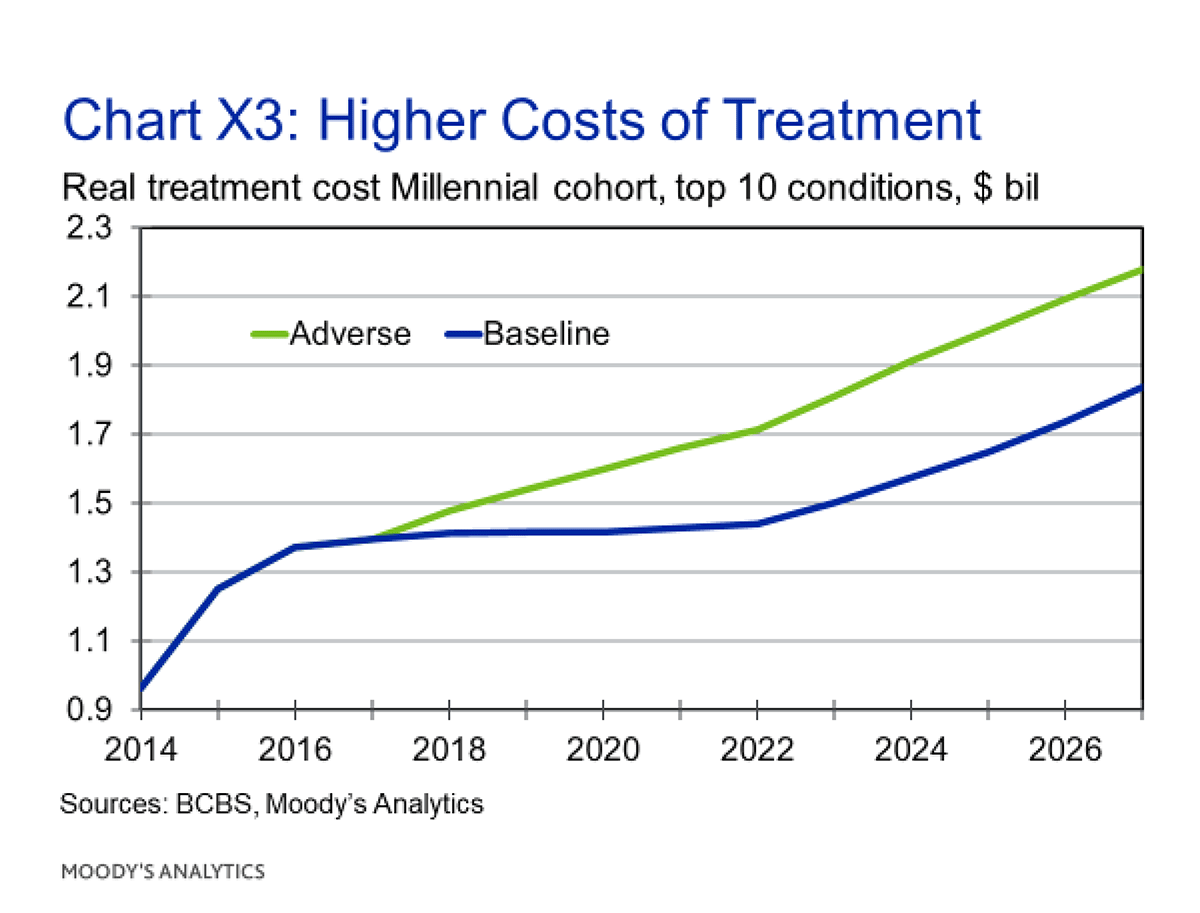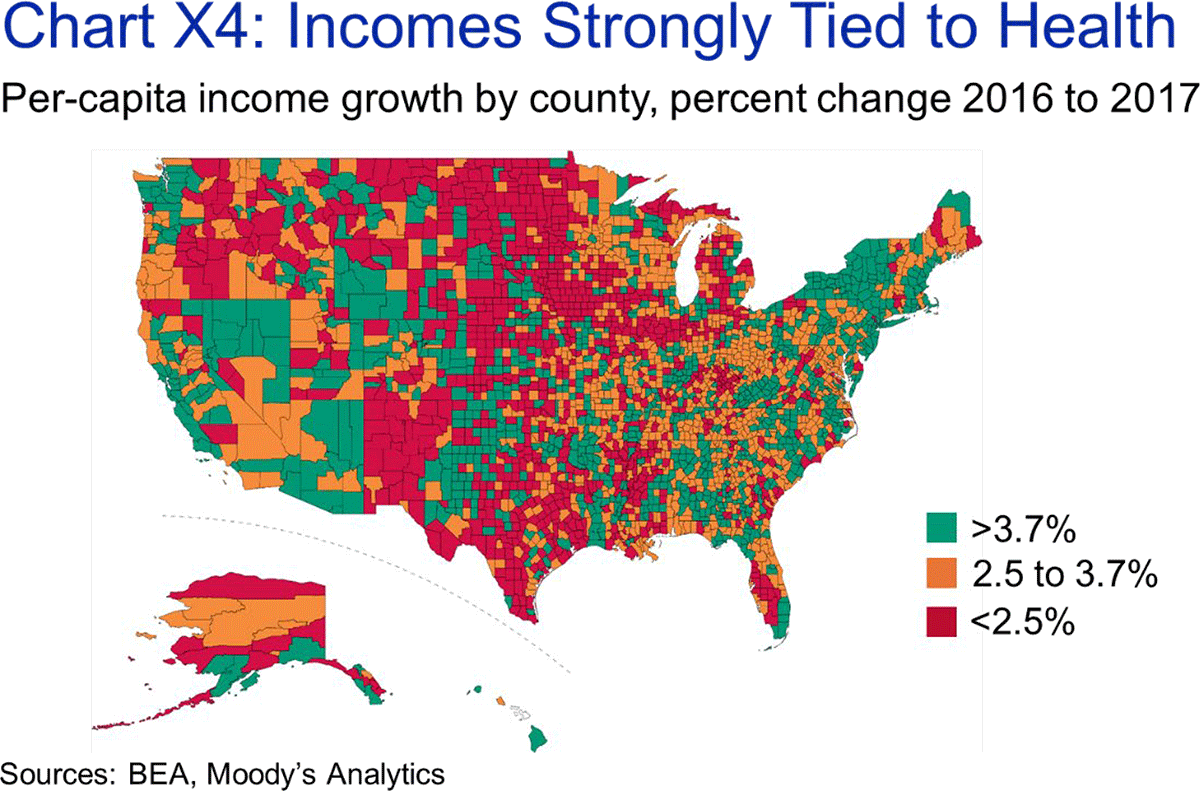The Economic Consequences of Millennial Health

Executive Summary
In the course of the last several years, millennials have shown that they are very different from previous generations in a number of ways. Defined as the generation born from 1981 to 1996, they are the largest, most educated, and most connected generation the world has ever seen1. However, recent data also show the beginnings of troubling generational health patterns that could hamper the future prosperity of millennials, and in turn the prosperity of the U.S. If the current pace of decline in millennial health continues unabated, the long-term consequences to the U.S. economy could be severe.
Millennials now make up the largest share of the U.S. population and labor force, placing them at the heart of U.S. economic growth as consumers, workers, and business owners. How their health plays out in the years ahead will determine not only the overall health of the country, but also its potential economic trajectory. By using Blue Cross Blue Shield Health Index data to analyze these questions, we are able to take a much broader and forward-looking view of these impacts relative to previous studies. In our examination of millennial health patterns we have found several interesting and concerning findings, particularly regarding future impacts on healthcare costs and economic activity.
- Millennials are seeing their health decline faster than the previous generation as they age. This extends to both physical health conditions, such as hypertension and high cholesterol, and behavioral health conditions, such as major depression and hyperactivity. Without intervention, millennials could feasibly see mortality rates climb up by more than 40% compared to Gen-Xers at the same age.
- These accelerated declines will result in greater demand for treatment and higher healthcare costs in the years ahead. Under the most adverse scenario, millennial treatment costs are projected to be as much as 33% higher than Gen-Xers experienced at a comparable age.
- Poorer health among millennials will keep them from contributing as much to the economy as they otherwise would, manifesting itself through higher unemployment and slower income growth. Under the most adverse set of projections, lower levels of health alone could cost millennials more than $4,500 per year in real per-capita income compared to similarly aged Gen-Xers. Such impacts would be most likely concentrated in areas already struggling economically, potentially exacerbating instances of income inequality and contributing to a vicious cycle of even greater prevalence of behavioral and physical health conditions.
These findings should serve as a call to action among policymakers and the healthcare community at large to address declining health among younger Americans before the more severe consequences in this analysis become reality. If nothing is done, the impacts could be game-changing for the U.S. and its economy.
Projecting millennial health outcomes
To better quantify the potential consequences of continued health declines, Moody’s Analytics constructed ten-year forecasts for millennial health using data from the Blue Cross Blue Shield Health Index.2 The forecasts are composed of two different scenarios, baseline and adverse. The baseline represents how health shocks have historically played out, and the adverse represents a continuation of current trends throughout the next decade.

The two scenarios provide us a plausible range of outcomes as to the potential severity of the millennial health shock. At its core the adverse is a continuation of the patterns seen over the past several years. Therefore, to the extent that those patterns are expected to continue out into the future, the adverse is the most plausible scenario, while to the extent a reversion to historical health patterns is expected, the baseline is the most plausible scenario.
Which projection ultimately proves the most accurate may boil down to the speed and degree of intervention by key stakeholders in response to the current pace of decline.
Health shocks, in terms of mortality, have been captured by government data since 1960. They were experienced by both the Silent Generation and baby boomers as they came into their mid-30s. These health shocks can be traced back to specific circumstances such as the Vietnam War, increases in recreational drug use, and the outbreak of HIV/AIDS. The current uptick in millennial mortality is representative across a wide range of causes and is still in its early onset. The limited nature of the mortality data makes it difficult to pinpoint a specific cause of the most recent uptick, given that the overall mortality rate is up across the board, from overdoses to cancers.

One key to the millennial health shock may be behavioral health, given how much the recent decline has been attributable to rapid upticks in conditions like depression, substance abuse, and hyperactivity. Between 2014 and 2017 alone, prevalence of major depression and hyperactivity among millennials was up roughly 30%. What’s more, according to the CDC, accidental deaths, which include overdoses, and suicides were the cause of 60% of the deaths among 25-29 years old in 2017. A generation before, in 2002, those two causes accounted for less than half of all deaths in the same age cohort.

Counting the cost
The logical first consequence of these overall health declines is an increase in the amount of treatment that will need to be accessed. This, of course, is not without cost. A rapid increase in the need for treatment for the most populous generation in the U.S. has the potential to tax our already burdened healthcare infrastructure. The U.S. already spends more than 18% of its GDP on healthcare expenditures, the highest in the developed world. These additional cost pressures would be borne not only by consumers and businesses, but by states and the federal government as well, adding to already mounting mandatory spending burdens.
By combining the average cost per treatment from the Blue Cross Blue Shield Health Index data and a projection of the number of patients seeking treatment consistent with our baseline and adverse health scenarios, we can see real overall costs of care soar over the next decade.

These projections are again driven in large part by much higher millennial prevalence rates for behavioral health conditions, which prove to be some of the more costly treatments for individuals in the millennial cohort.

The uptick in physical health prevalence among millennials is less of an immediate concern given how relatively inexpensive treatment for most of these conditions is earlier in life, but storm clouds are forming just beyond the horizon. Millennials show particularly elevated prevalence for high cholesterol and hypertension, both of which have a tendency to grow more expensive over time as their cumulative effects begin to manifest into other more serious conditions like heart or cerebrovascular diseases.
The youngest millennials won’t turn 40, around the time when most of these conditions historically begin to reach critical mass, for another 17 years. Thus, the projected increases in millennial healthcare costs over the next ten years may only be the tip of the iceberg, with more serious implications to come.
Less health, less wealth
The second important consequence of a less healthy millennial population is slower economic growth. Our previous research has shown strong correlations between health and economic conditions, particularly that healthier workers also tend to be more productive workers.
As millennials become less healthy, they are more likely to miss work or stop working altogether. Furthermore, even when they are working, health concerns may prevent them from being as productive as they would have been had they had the same health profile as previous generations.
These potential consequences take on added importance when we take into account the outsize role that millennials will play in the economy over the coming decade. Millennials are now the largest contributors to the U.S. labor market, comprising more than 35% of all workers and rising.
Comparing projections for the oldest millennials to observed data on the youngest Gen-Xers, incomes are likely to see the biggest adverse effects as productivity declines. Under the most extreme scenario the oldest Millennials could see real incomes of more than $4,500 less per person ten years from now than the youngest Gen-Xers enjoy today.

In addition to a slower overall pace of growth, millennial health patterns may also exacerbate some underlying economic issues as well, most notably income inequality. Having previously established the fact that there is a strong correlation between overall health and several important economic measures, regression analysis on the relationship between millennial health specifically confirms this relationship, particularly with measures such as growth in house prices and per-capita incomes. Based on these statistical relationships we can conjecture that some of the areas that may see the largest economic drag from lower millennial health are areas with already below average economic outcomes.

As with the U.S. population as a whole, millennials who live in areas with better economic outcomes generally have higher levels of overall health relative to other millennials. In turn, declines in millennial health are generally most acute in areas of the country that are already falling behind economically. A continuation of these declines, without intervention, risks exacerbating this disconnect even further.
Lastly, these long-term economic impacts also have the potential to reinforce long-term declines in health. Several survey-based studies have found that one of the potential causes of increased depression, alcohol use, and substance abuse among millennials are worries about finances3.
If we hold such a hypothesis to be true in the context of this study, then millennial health patterns can cause declining millennial economic outcomes that in turn can cause further declines in millennial health. This represents a potentially vicious cycle resulting in even higher prevalence of depression and other behavioral health conditions over time.
Delving deeper into the relationship between millennial finances and behavioral health would provide a better understanding of what the future looks like in terms of overall health outcomes. Seeking out answers with regard to these correlations could help better explain some of the root causes of changing millennial health patterns, and provide stakeholders with guidance on the best ways to limit the potential economic fallout in the years to come.
Footnotes
- Dimock, Michael; Defining generations: Where Millennials end and Generation Z begins; Pew Research Center, January 17, 2019
- The BCBS Health Index is a unique measure of the health of Americans using the claims data of more than 41 million BCBS commercially insured members. The Health Index quantifies the overall health of U.S. population using a score between 0 and 100. A score of ‘100’ represents optimal health -- a population's potential lifespan, absent any conditions that lead to disability and increased risk of death. Any score less than 100 represents a reduction in health due to presence of conditions that lead to disability and increased risk of death.
- Stress in America, Paying With Our Health; American Psychological Association, February 4, 2015
